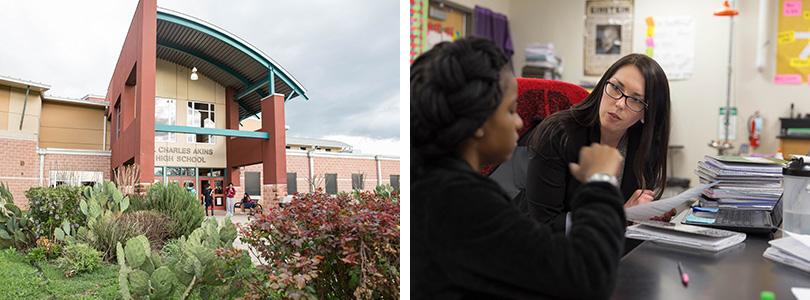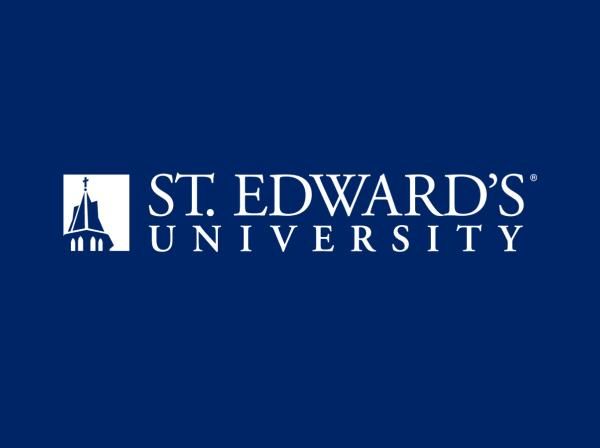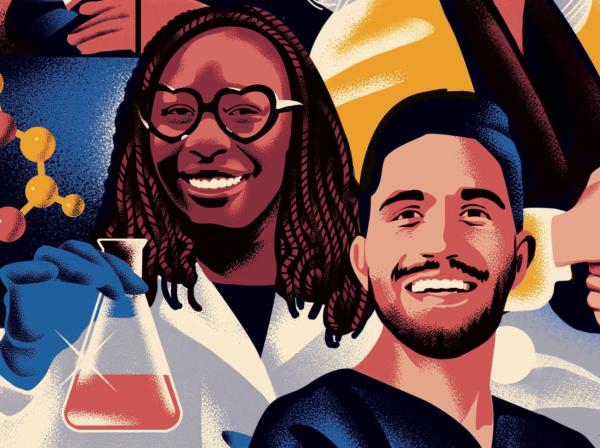Helping Teachers Succeed
How hard is teaching? High-school biology teacher Angie Lux ’12 faces changing rules, changing tests and changing curriculum, all on top of exciting teenagers about science. But she’s also getting ongoing support from her alma mater.
Angie Lux ’12 digs her toes into the cool Costa Rican sand and raises her binoculars. The moon rises over the beach near Tortuguero as she scans the horizon, looking for one tiny thing. Hundreds of them, actually — the baby sea turtles that have poked their way out of ping-pong-ball-sized eggs.
As Lux watches for signs of the tiny creatures scurrying down to the frothy waves on the dark beach, she thinks about the week she’s spent with her classmates and her high-school ecology teacher, Jim Kuban. It’s the spring of her senior year, and graduation is only a couple months away — but it feels a world away in the rainforest. Lux and her classmates have spotted a toucan and a bright yellow eyelash viper at the lodge; marveled at large fruit bats on a night hike; and studied Chelonia mydas — green sea turtles — and the ways they can increase the endangered creatures’ chances of survival.
Lux spots the first hatchling as it treks toward the moonlit water, driven by an innate force she can’t see. Suddenly, she’s just as clear about her own trajectory. She wants to have experiences like this again. She wants a career in biology.
Odd Woman Out
It’s been nine years since her senior class trip to Costa Rica, and Lux has followed that trajectory, graduating from St. Edward’s University with a degree in Biology and a minor in Education and earning her teacher certification in Life Sciences. Channeling her love for biology into a career as a teacher, she says, was a natural response to Kuban’s tireless enthusiasm. It was also because of Ms. Loughry, the kindergarten teacher who helped Lux perfect the loopy “g” in her own name; and Mrs. Krick, who spent English class discussing books and listening with empathy to middle-school angst.
“Science was always my thing — that’s what I loved,” Lux says, “but I had teachers in different grades and subjects all through school that helped shape the person I grew up to be. When my biology professors at St. Edward’s started asking me to think about how I wanted to use my degree, I kept coming back to teaching.”
Now in her fourth year as a biology teacher, Lux has seen more than 600 students pass through her classroom. She’s devised countless lessons to meet the state’s often onerous curriculum requirements, better known as the TEKS (Texas Essential Knowledge and Skills) — and administered its accompanying yearly State of Texas Assessments of Academic Readiness, or STAAR, to nearly all of her students. There is very little time in her four-period school day for instilling the sense of wonder about the natural world she felt on that Costa Rica beach nine years ago.
But Lux was ready for that.
She knew well before her first day as a full-time teacher that she had even odds of success — the job is so difficult that 40 to 50 percent of new teachers leave education altogether within five years. The reason she’s successfully managed four years with no plans to quit, she says, comes down to one word.
Noyce.
Early and Often
As a junior at St. Edward’s, Lux was selected for the Robert Noyce Teacher Scholarship Program, a National Science Foundation (NSF) initiative that identifies talented upperclassmen with STEM majors — science, technology, engineering and mathematics — and helps them pursue teaching careers in elementary, middle and high schools. The Noyce program at St. Edward’s (directed by the School of Education with partners in the School of Natural Sciences) was initially funded by an $885,000 NSF grant in 2008 and launched in 2009, perfect timing for Lux to participate.
When Lux started her teacher preparation courses in the School of Education, she, quite literally, went back to high school. College courses are taught in the field, and future elementary, middle and high-school teachers from St. Edward’s are immersed in the environment where they’ll soon be working. “We got over that initial feeling of being terrified by teenagers, and young people in general, right away,” Lux recalls. “That was huge.”
Lux completed three internships at Austin-area middle and high schools before starting her final semester student-teaching. She planned and implemented mini-lessons (the best moment: presenting about her week in Costa Rica; the worst: forgetting to put on goggles during a lesson on lab safety). She got real-time feedback and advice from the mentor teachers in whose classrooms she worked. And with guidance from her professors, she watched and critiqued videos of herself teaching. Before she graduated, Lux had already spent more than 500 hours in a real classroom teaching real students. In 2012 she was hired to teach biology at Del Valle High School, one of the schools where she had interned.
“Once I was in the field and heard from other teachers about their undergraduate programs, I saw just how well we had been prepared,” says Lux, who now teaches at Akins High School in Austin. “My first day, I texted one of my professors and thanked him.”
That’s the philosophy throughout the School of Education, says Associate Professor of Secondary Education Steven Fletcher. “The national literature about teacher preparation shows that clinical field experience is absolutely crucial,” he says. “Our strategies bear out that theory time and time again.”
Preparation “early and often” is key to keeping stars like Lux (and all teachers) from burning out, says Fletcher. “The earlier we can place future teachers in real settings with real students, the more comfortable they are walking into their own classrooms,” he says. “They aren’t naive about what to expect, and they know how to be successful or where to turn when something is not working.”

Teaching with Toothbrushes
On a chilly November afternoon — the first truly cold day of fall — scarves and jackets lie on a Fleck Hall conference table, heaped perilously close to a few coffee cups. Lux and about 50 other Central Texas teachers — a mix of rookies, veterans, administrators and home-schoolers — fill the gray chairs, sit cross-legged on the floor or stand near the cold windows. At the head of the class is Fletcher.
This is his Texas STEM Teacher Circle, a networking group Fletcher created three years ago for School of Education students and alumni, as well as STEM teachers and administrators from across Central Texas. On this frigid day, the group bats around ideas about the Maker Movement, a national trend that encourages students to tinker, create and experiment. Earlier in the afternoon, Lux and the other teachers broke into small groups to hear from circle members who have already involved their students in maker-type projects like reverse-engineering toys and turning toothbrushes into robots. Now, Fletcher moderates a conversation about how they all might implement similar lessons.
Lux is a regular at the monthly STEM circle meetings. They’re valuable, she says, because she gets to see how other teachers are doing innovative things in their classrooms — and managing to fit new ideas into the curriculum requirements outlined by the Texas Education Agency. “I’m always thinking about which TEKS lesson a new experiment or project might go with,” she says. “It’s a hard match to make because I also have to take into account what level my students are at, what supplies we’ll need, how we’ll get those supplies, and how much time it will take me to prepare.”
The STEM circle is a sounding board for those kinds of concerns, and the monthly sessions have the added benefit of serving as part of a new teacher’s induction, defined in the education world as professional development and training for teachers in their first through third years. Induction, coupled with better and more frequent classroom preparation, is the best way to stop or at least slow the exodus of novice teachers, Fletcher and other education experts believe.
“The data shows us that new teachers need a lot of socialization, time and support to acclimate,” he says. “You can’t be expected to jump in and excel from day one without training, guidance, peer support, decently equipped classrooms, and opportunities to do something cool or fun or different, even if it’s not explicitly outlined in the mandated curriculum.”
With two new grants in the coffer — an additional $294,000 from the NSF and $47,000 from the Powell Foundation — Fletcher and his colleagues have now launched teacher circles for literacy, bilingual education and elementary education. Another for special education is in the planning stages.
“What’s emerging and evolving is that teachers need more than general induction support,” says Fletcher. “They need specific support in their particular content area — that’s what they find most useful.”
In addition to content-sharing, the circles are a way to commiserate about challenges and celebrate successes with “a community that listens, is empathetic and communicates a joy for the profession,” says Shelly Rodriguez, a 12-year veteran science teacher who started mentoring Lux through the Noyce program. (Rodriguez is the former science department chair at Crockett High School in Austin and is also a clinical associate professor in the University of Texas’ UTeach program.) “That support is so very important because it’s challenging to make sense of the ecosystem of a school and how all the moving parts work together.”
Feeling Blue
At 8:47 on a Thursday morning in January, the ecosystem that is Akins High School is bustling. Cars move through the drop-off line. Buses unload. Hundreds of rolls bake in the cafeteria’s industrial ovens. By 9:15, 11 ninth graders and their accouterments — notebooks, loose-leaf, pencils, a basketball — sprawl across two rows of rectangular tables in Lux’s second-floor classroom. Everyone is wearing black, except one kid in gleaming orange high tops and another in camo Chuck Taylors.
This is Lux’s first and smallest class of the day — Environmental Systems for freshmen who need extra help getting ready for biology next year. Today’s lesson is photosynthesis. Lux draws a data table on the overhead projector, and the kids dutifully copy it down. She explains that they’re going to fill three test tubes with water and a chemical called bromothymol blue, or BTB, which turns green in the presence of carbon dioxide. They’ll add carbon dioxide to their tubes, place a sprig from an elodea plant (a waterweed often used in aquariums) in two of the them, cover one with a paper towel to keep out the light, and put the other in a rack on the sunlit back window. The third tube will be their control. At the end of the class period, the color of the liquid in the tubes will demonstrate whether the plants added oxygen to the water — and by extension, what conditions are necessary for photosynthesis.
To demonstrate how the BTB works, she puts a few drops of blueberry-colored liquid in a beaker of water and blows into it with a straw until the mixture turns the color of peas. After some discussion, her students agree that Lux added carbon dioxide to the beaker when she blew into it, which caused the color change. “This will be important later,” Lux hints. “Remember what it means when the liquid is green and what it means when it’s blue.”
The students disperse to their lab stations and start setting up their test tubes. One kid accidentally sucks water and BTB up the straw and into his mouth. He spits and gargles while his lab partners cackle. Another kid blows into the straw too forcefully and splatters her glasses and the blond tips of her black hair. Eventually, all the tubes are assembled and in place. An hour later, when the students return to their tubes, they’ll find that the water in the sunlit, elodea-containing tube has reverted to blue — but first, Lux has questions.
When the students return to their desks, she asks about the differences between photosynthesis and its opposite process, cellular respiration.
Eyes shift and pencils go still. “Anyone?” she asks. “Okay, take a deep breath,” she says. “Now, put your hand in front of your mouth and breathe out.” They do. “What do you feel?”
“It’s wet,” somebody says.
“It’s warm,” somebody else says.
“Yeah, it’s kind of sticky,” says the kid with the basketball.
“That’s right,” says Lux. “Your body just made water. Let’s do it one more time … Oxygen in, carbon dioxide out, you just made water AGAIN!” A few students laugh. A few others snort.
“The oxygen is helping us make water, which is a byproduct of cellular respiration, which is the opposite of what our plants in the window are doing,” she says, connecting the scientific dots. “So, why do we need oxygen but plants don’t? Why can’t we function without it? Have you ever thought about that?”
A few seconds tick off the industrial black clock on the wall above Lux’s overhead. “Not until now,” the kid with the camo shoes finally says.
And that’s the moment.
That’s the moment that separates an inexperienced teacher from an experienced one. The moment the planned lesson gets temporarily shelved so the spontaneous one can take over. The moment every student in the class is focused on understanding the why and the how of a concept they skimmed, or maybe skipped, in their textbook last week.
It’s the kind of moment Lux is always looking for, says her mentor Rodriguez, because “one of Angie’s strengths as a teacher is the heart she has for her kids and their learning — first and foremost, she is an advocate for them.”
And four years into that critical five-year mark that so many teachers never reach, Lux is quickly becoming an advocate for new teachers like herself. She is already mentoring a first-year teacher she met through a colleague at Akins. In December, Lux will complete her MEd in Curriculum and Instruction with a science emphasis through a distance-learning program at the University of Texas–Arlington. “Dr. Fletcher always tells us, ‘Get to know your students and help them get to know you. Be honest and be reasonable. Transparency is key.’” Lux says. “I love teaching science, but it’s not just about the subject. It’s about who you’re teaching and how you build relationships,” she says.


